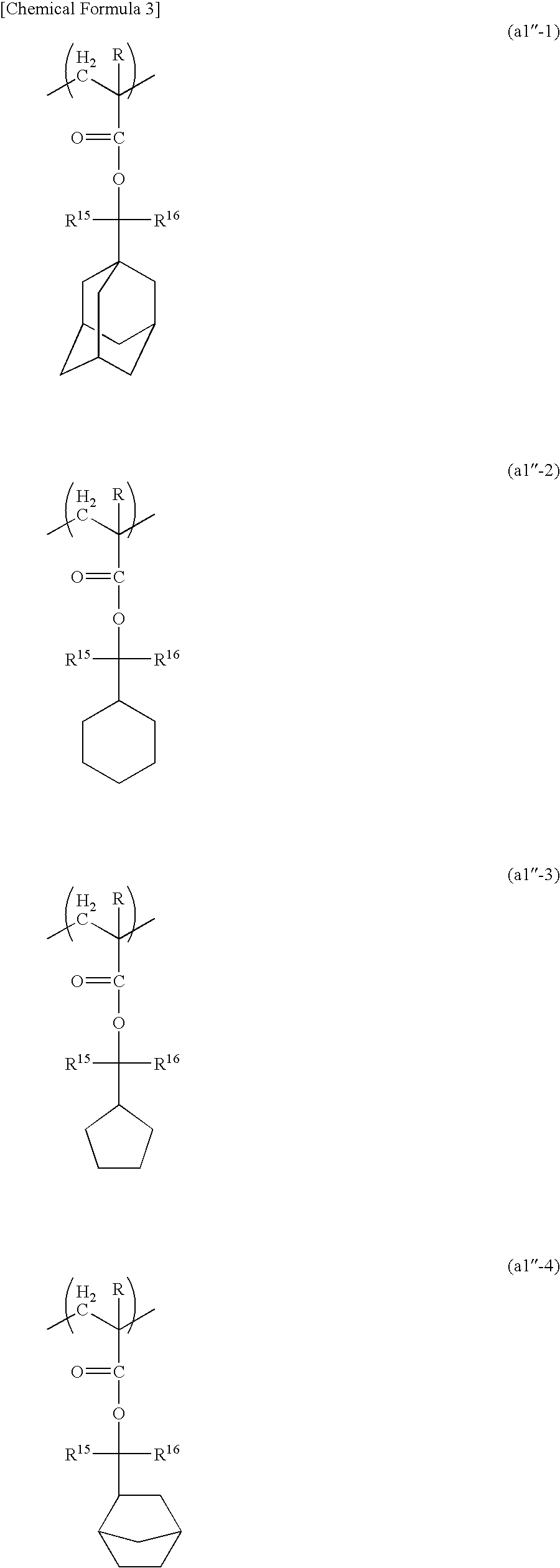Resist composition, method of forming resist pattern, compound and acid generator including the same
a technology of resist pattern and composition, applied in the direction of photosensitive materials, instruments, photomechanical equipment, etc., can solve the problems of resist pattern footing, defect occurrence, and the solubility of acid generators in alkali developing solution deterioration,
- Summary
- Abstract
- Description
- Claims
- Application Information
AI Technical Summary
Benefits of technology
Problems solved by technology
Method used
Image
Examples
synthesis example 1
[0791]16.0 g of a compound (1-1) (manufactured by Wako Pure Chemical Industries, Ltd.) and 131.7 g of pure water were added to a three-necked flask, and 5.20 g of hydrochloric acid was then dropwise added thereto. The resultant was then refluxed while heating for 12 hours. The obtained aqueous phase was then washed with 131.7 g of t-butyl methyl ether (TBME), thereby yielding 10.0 g of a compound (1-2).
[0792]Then, the compound (1-2) was analyzed by NMR.
[0793]1H-NMR (DMSO-d6, 400 MHz): δ (ppm)=2.30 (d, 6H, Ha), 4.53 (s, 2H, Hb), 7.59 (s, 2H, Ar), 7.71-7.89 (m, 10H, Ar).
[0794]From the results shown above, it was confirmed that the compound (1-2) had the structure shown below.
synthesis example 2
[0795]45.3 g of pure water and 90.5 g of dichloromethane were added to 20 g of the compound (1-2), and 16.8 g of potassium nonafluorobutane sulfonate was further added thereto, followed by stirring at room temperature for 15 hours. Thereafter, the resultant was subjected to liquid separation to collect a dichloromethane phase, and the obtained dichloromethane phase was washed twice with 45.3 g of diluted hydrochloric acid, and was then washed four times with 45.3 g of pure water. The resulting dichloromethane phase was concentrated, dried and solidified, thereby obtaining 26.4 g of a compound (2-1) in the form of a white solid.
[0796]Then the compound (2-1) was analyzed by NMR.
[0797]1H-NMR (DMSO-d6, 400 MHz): δ (ppm)=2.30 (d, 6H, Ha), 4.39 (s, 2H, Hb), 7.32 (s, 2H, Ar), 7.70-7.87 (m, 10H, Ar).
[0798]19F-NMR (DMSO-d6, 376 MHz): δ (ppm)=−123.7, −119.3, −112.4, −78.6.
[0799]From the results shown above, it was confirmed that the compound (2-1) had the structure shown below.
synthesis example 3
[0800]In a nitrogen atmosphere, 8.54 g of the compound (2-1) and 42.7 g of THF were added to a three-necked flask, and the compound (2-1) was completely dissolved in THF and cooled to 5° C. or lower. 4.81 g of ethyl-N,N-dimethylaminopropyl carbodiimide hydrochloride was added to the resulting solution, followed by stirring at 10° C. or lower for 5 minutes, and 3.77 g of 1H,1H-pentafluoropropanol was then dropwise added thereto. Thereafter, following stirring for 5 minutes, 0.31 g of N,N-dimethylaminopyridine was added thereto, followed by elevating the temperature to room temperature, and a reaction was then effected at room temperature for 30 hours. After completion of the reaction, the organic phase separated by filtration was concentrated, and 42.7 g of dichloromethane was then added thereto to completely dissolve the concentrated organic phase. The obtained dichloromethane phase was washed with diluted hydrochloric acid, and was then further washed with pure water repeatedly unt...
PUM
| Property | Measurement | Unit |
|---|---|---|
| Fraction | aaaaa | aaaaa |
| Fraction | aaaaa | aaaaa |
| Fraction | aaaaa | aaaaa |
Abstract
Description
Claims
Application Information
 Login to View More
Login to View More - R&D
- Intellectual Property
- Life Sciences
- Materials
- Tech Scout
- Unparalleled Data Quality
- Higher Quality Content
- 60% Fewer Hallucinations
Browse by: Latest US Patents, China's latest patents, Technical Efficacy Thesaurus, Application Domain, Technology Topic, Popular Technical Reports.
© 2025 PatSnap. All rights reserved.Legal|Privacy policy|Modern Slavery Act Transparency Statement|Sitemap|About US| Contact US: help@patsnap.com



